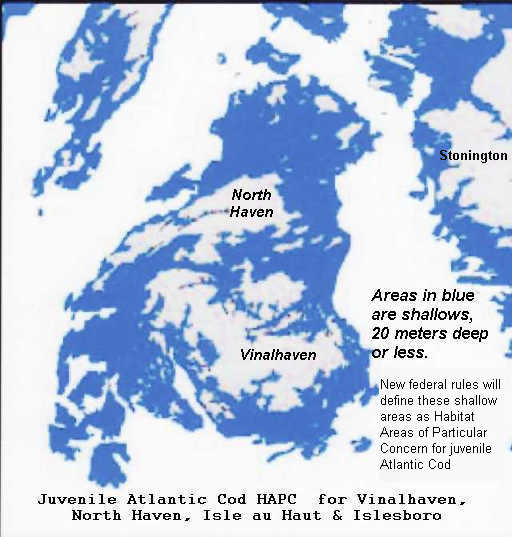New: Coastal Science WIKI
Current bay ecology issues
Sears Island. estuary protection effort or container port_
Marine windfarms, Tidefarms & Current farms Seagrant reviews the ecological impact of these_
Why pollution matters. Larval Fish need Baby Food According to the Woods Hole Oceanographic Institute freshly hatched atlantic cod larvae require as immediate prey a high density in the water of soft-bodied marine microbes called amoebas. For the first 10-15 days after hatching, larval cod lack jaws capable of breaking open for the tiny fish to survive the first ten to fifteen days of their lives.
As the WHOI researchers put it, the tiny fish require:
"soft-bodied microzooplankton in the size range of 40 to 80 m at a nominal concentration of about 2 cells ml-1 in order to maximize survival through yolk-sac absorption (~10-15 days post-hatch)."
Yet daily, a smorgasbord of herbicides, pesticides, hydrocarbons, plastics, heavy metals and more arrive in Penobscot Bay's shallows, where the codlets are enjoying their first 10 to fifteen days. Or hungrily trying to.
What can be the impact, singly and combined of these chemicals on the survival of the marine amoebas needed by baby cod? Let alone the needs of other fishes. In the absence of data one must only guess, but it is reasonable to believe there could been a change over the toxic twentieth century both in the types of marine bacteria in our bay shallows and in their quantity.
Stay tuned.
BAY ECOLOGY - HISTORY
19th century fisheries & scientific exploration of the Gulf of Maine marine and river fisheries before chemical pollution, dragger fisheries and other impacts changed things. And more.
BAY ECOLOGY - AGENCIES
NOAA Fisheries - Habitat Conservation Division, New England
Get their Monthly Highlights **
NOAA NE Federal Register
NEFMC Habitat/Marine Protected Areas Program
BAY ECOLOGY - ACADEMIA
Friends of the Benthos (Les Watling's Research webpages)
Gulf of Maine Research Institute
Three Hundred Wild Fishing Grounds of the Gulf of Maine
New federal regulations affecting New England's marine shallows are near to enactment. First approved in 1999, they were delayed from enactment by bureacracy. But now NOAA is moving forward on this and other "Habitat Areas of Particular Concern".

Figure shows HAPC in central Penobscot Bay, but will also protect nearshore juvenile cod habitat, (shallows out to 30 feet deep) along the coasts of Rhode Island, Massachusetts, New Hampsire and Maine's border with Canada, human activities that could harm the baby Atlantic cod, or their essential prey microbes, must be prevented, stopped and reduced, as circumstances mandate. (Industrial harbors and other working waterfronts are largely exempted.)
Results of Penobscot Bay Salmon post-smolt trawl surveys 2000 to 2004.